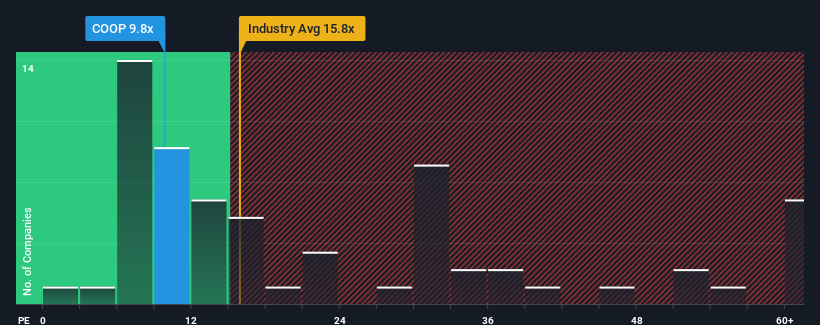- United States
- /
- Diversified Financial
- /
- NasdaqCM:COOP
Sentiment Still Eluding Mr. Cooper Group Inc. (NASDAQ:COOP)

Mr. Cooper Group Inc.'s (NASDAQ:COOP) price-to-earnings (or "P/E") ratio of 9.8x might make it look like a buy right now compared to the market in the United States, where around half of the companies have P/E ratios above 18x and even P/E's above 33x are quite common. Although, it's not wise to just take the P/E at face value as there may be an explanation why it's limited.
Mr. Cooper Group has been struggling lately as its earnings have declined faster than most other companies. It seems that many are expecting the dismal earnings performance to persist, which has repressed the P/E. You'd much rather the company wasn't bleeding earnings if you still believe in the business. If not, then existing shareholders will probably struggle to get excited about the future direction of the share price.
View our latest analysis for Mr. Cooper Group

Is There Any Growth For Mr. Cooper Group?
In order to justify its P/E ratio, Mr. Cooper Group would need to produce sluggish growth that's trailing the market.
Retrospectively, the last year delivered a frustrating 42% decrease to the company's bottom line. Even so, admirably EPS has lifted 132% in aggregate from three years ago, notwithstanding the last 12 months. So we can start by confirming that the company has generally done a very good job of growing earnings over that time, even though it had some hiccups along the way.
Shifting to the future, estimates from the six analysts covering the company suggest earnings should grow by 20% each year over the next three years. With the market only predicted to deliver 10% per year, the company is positioned for a stronger earnings result.
With this information, we find it odd that Mr. Cooper Group is trading at a P/E lower than the market. It looks like most investors are not convinced at all that the company can achieve future growth expectations.
The Key Takeaway
We'd say the price-to-earnings ratio's power isn't primarily as a valuation instrument but rather to gauge current investor sentiment and future expectations.
Our examination of Mr. Cooper Group's analyst forecasts revealed that its superior earnings outlook isn't contributing to its P/E anywhere near as much as we would have predicted. When we see a strong earnings outlook with faster-than-market growth, we assume potential risks are what might be placing significant pressure on the P/E ratio. At least price risks look to be very low, but investors seem to think future earnings could see a lot of volatility.
It's always necessary to consider the ever-present spectre of investment risk. We've identified 1 warning sign with Mr. Cooper Group, and understanding should be part of your investment process.
Of course, you might find a fantastic investment by looking at a few good candidates. So take a peek at this free list of companies with a strong growth track record, trading on a low P/E.
New: Manage All Your Stock Portfolios in One Place
We've created the ultimate portfolio companion for stock investors, and it's free.
• Connect an unlimited number of Portfolios and see your total in one currency
• Be alerted to new Warning Signs or Risks via email or mobile
• Track the Fair Value of your stocks
Have feedback on this article? Concerned about the content? Get in touch with us directly. Alternatively, email editorial-team (at) simplywallst.com.
This article by Simply Wall St is general in nature. We provide commentary based on historical data and analyst forecasts only using an unbiased methodology and our articles are not intended to be financial advice. It does not constitute a recommendation to buy or sell any stock, and does not take account of your objectives, or your financial situation. We aim to bring you long-term focused analysis driven by fundamental data. Note that our analysis may not factor in the latest price-sensitive company announcements or qualitative material. Simply Wall St has no position in any stocks mentioned.
About NasdaqCM:COOP
Mr. Cooper Group
Operates as a non-bank servicer of residential mortgage loans in the United States.
Undervalued with reasonable growth potential.

